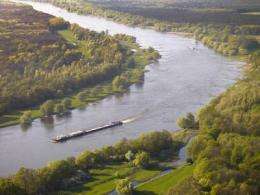Pesticides pollute European waterbodies more than previously thought

Pesticides are a bigger problem than had long been assumed. This is the conclusion of a study in which scientists analysed data on 500 organic substances in the basins of four major European rivers. It was revealed that 38 per cent of these chemicals are present in concentrations which could potentially have an effect on organisms. According to scientists writing in the journal Science of the Total Environment, this conclusion clearly shows that contamination by organic chemicals is a problem throughout Europe. Most of the substances classified as a risk to the environment in the study were pesticides; the majority of these are not on the European list of priority substances which have to be monitored regularly. They therefore believe that the list of chemicals specified by the EU Water Framework Directive as having to be monitored by national authorities urgently needs to be revised.
The aim of the EU Water Framework Directive is that surface water and groundwater bodies should reach a good environmental and chemical status by 2015. The chemical status will be assessed based on a list of 33 so-called priority pollutants. As over 14 million chemicals are on the market and over 100,000 of these are produced on an industrial scale, the authorities have to confine their monitoring to a manageable number of pollutants. Throughout Europe scientists are therefore working on methods to establish which pollutants these should be.
An important contribution to this has now been made by a study completed by the scientists of the Helmholtz Centre for Environmental Research (UFZ) together with colleagues in France, Slovakia, Belgium and Spain. They analysed a database compiled for the EU MODELKEY research project which contains five million records on physicochemical data. The study focused on organic pollutants recorded in over 750,000 entries of water analyses in the basins of the Elbe (Czech Republic/Germany), the Danube (10 neighbouring European countries), the Schelde (Belgium) and the Llobregat (Spain) rivers. According to the European Commission, this is the first study which has developed a system which has classified organic pollutants on the basis of assessment criteria and the need for action.
One of the most frequently registered compounds was diethylhexyl phthalate (DEHP), a chemically-produced softener which may impair fertility and is therefore banned in the EU from 2015. This is followed by another softener bisphenol A (BPA), which may also impair fertility, and diclofenac and ibuprofen, two pharmaceutical substances used commonly in painkillers.
The scientists classified a total of 73 compounds as potential priority pollutants. Around two thirds of these are pesticides, i.e. products used in agriculture to protect crops against disease, pests and weeds. The most problematic pesticides were diazinon, which is already no longer allowed in Germany and Austria, as well as azoxystrobin and terbuthylazine, which are still allowed in Central Europe. "Neither of these pesticides is on the list of 33 priority pollutants, which have to be monitored by authorities throughout the EU," explains UFZ researcher Dr. C. Peter von der Ohe. "Terbuthylazine is a compound that is structurally closely related to the priority pollutants simazine and atrazine, which may not be applied any more. This is a nice example how small structural modifications of chemical products may apparently improve the chemical status without mitigating any hazards to the aquatic ecosystems." Thus, the scientists strongly support that the priority pollutant list is regularly updated.
Today the majority of the substances currently presenting problems are not listed, while many of the chemicals being monitored have been banned for some time and are no longer used. "We were also surprised that substances previously classified as harmless, such as HHCB, which is used as a synthetic musk fragrance in personal care products, are present in the environment in alarming concentrations," adds Dr. Werner Brack of the UFZ, who advises the European Commission in various committees and projects on the revision of the list of priority pollutants. "In our opinion the development of the Water Framework Directive should ensure that in future not only the presence of chemical substances but also their effects are monitored," suggests Brack.
For all of the criticism that the water authorities in Europe are currently paying too little attention to pesticides and that the list of priority pollutants should be revised, in the opinion of the scientists the study also reveals the first successes of the Water Framework Directive. One third of the pollutants classified as priority a few years ago by the EU now no longer present a risk to the rivers studied. Tilo Arnhold
On 12&13 October 2011, a conference on Integrated Water Resources Management (IWRM) takes place in Dresden. About 400 scientists and colleagues from politics, administration, business companies and development cooperation from about 50 countries address the sustainable management of water resources in more than 100 presentations and numerous posters and discussions. Among others, the following current water related questions are discussed: How can the management of waters be designed in a sustainable manner in times of climate change? Which technologies contribute to an efficient and economical use of water? How can German know-how be used in developing and emerging countries? How can a flexible and integrated water resources management be designed? The conference is organised by the Helmholtz Centre for Environmental Research (UFZ), sponsored by the German Federal Ministry of Education and Research (BMBF) and supported by the International Water Association (IWA) and the Global Water Systems Project (GWSP). (http://www.bmbf.iwrm2011.de/)
More information: Von der Ohe PC, Dulio V, De Deckere E, Slobodnik J, Kühne R, Ebert R-U, Schüürmann G, Brack W 2011. A new risk assessment approach for the prioritization of 500 classical and emerging organic microcontaminants as potential river basin specific pollutants under the European Water Framework Directive. Sci. Total Environ. 409: 2064-2077. dx.doi.org/10.1016/j.scitotenv.2011.01.054
Provided by Helmholtz Association of German Research Centres
















